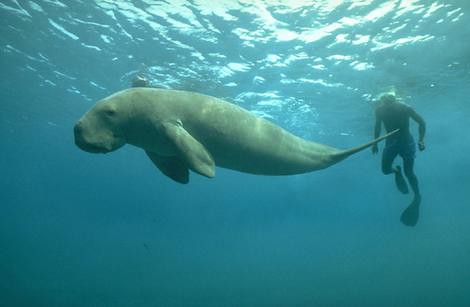Dugongs were once so plentiful in Queensland that observers commented that it would take hours for the 100 metre wide herds to pass by, the water thick with their wallowing movements.
Today, dugongs are officially recognised as being vulnerable to extinction.
Will the day come when there will no longer be dugongs in the clear shallow waters off the coast of Queensland, and the only place you’ll be able to see one is in an aquarium?
About dugongs
Also known as the sea cow, dugongs, which feed on seagrass, are the only marine mammal that feeds entirely on plants.
Their constant grazing keeps the seagrass beds in a healthy state for their role as fish nurseries, making them a key ingredient of a healthy marine ecosystem. Marine scientists know that where there are many dugongs, there are healthy waters.
Dugongs can live as long as 70 years, can weigh up to 400 kg and grow up to 3 m long.
Like elephants, the males and some older females grow tusks. In fact, dugongs are more closely related to elephants than they are to other marine mammals like dolphins and whales.
The closest living relative of the dugong is the manatee.
Dugongs inhabit shallow tropical waters and prefer the fresh new seagrass shoots over the older tougher plants. Like whales and dolphins, they must surface to breathe.
People are the greatest threat to dugongs
Humans are greatest threat to the existence of dugongs.
Many dugongs are killed by boat strike or by entanglement in fishing nets and marine debris.
But the biggest danger to dugongs is the destruction of their habitat, which is why the massively increased shipping, pollution and dredging involved in the proposed expansion of coal ports on the Great Barrier Reef coast pose such a danger for dugongs.
The dangers to dugongs of coal dust pollution
Dugongs, like other marine animals like snub-nosed dolphins and sea turtles are at risk of heavy metal pollution caused by the spread of coal dust.
Dr Kathy Burns at James Cook University showed that coal particulates in marine waters can travel 40 km to the outer Great Barrier Reef within 100 days from coastal coal ports at Abbot and Hay Point.
The direction of flow was to the south so other areas of nationally significant wetlands such as at Edgecumbe Bay to the south east are also likely to be impacted.
The impact this spread of coal dust and pollutants can be severe.
For example coal dust can contain heavy metals such as arsenic that can be taken up by seagrasses and ingested by marine animals such as dugongs, snub-nosed dolphins and sea turtles both of which are species listed under the Environment and Biodiversity Conservation Act 1999 (EPBC Act).
The massive expansion of coal ports along the Queensland coast adjacent to the Great Barrier Reef, including those at Abbot Point, Hay Point and Dudgeon Point thus clearly pose a threat to the future of dugongs.
Dugongs were a factor in the World Heritage Status of the Great Barrier Reef
The concentration of dugongs on the Great Barrier Reef is a significant reason the reef was granted World Heritage status.
The population of dugongs on this part of the Queensland coast is one of the largest and most concentrated remaining in the world. The Great Barrier Reef Marine Park Authority reports that the numbers of dugongs are decreasing.
Dugongs reproduce slowly and infrequently, and as a result, the combined levels of mortality are thought to be unsustainable.
That means they are dying faster than they are reproducing.
Protecting the dugong
In Australia, dugongs are protected under various pieces of legislation. They are listed as a marine and migratory species under the Commonwealth Environment Protection and Biodiversity Conservation Act 1999.
Dugongs are also protected by other Commonwealth legislation such as the Great Barrier Reef Marine Park Act 1975 where they are a protected species.
